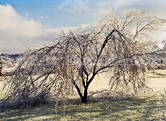 In
northern areas, when cold fronts sweep down from the
Arctic on the heals of a warm spell, the result is often
a rain storm during the day followed by hard freezing
temperatures for several days. When this happens, ice
may form on the branches of trees adding significant
weight load.
In
northern areas, when cold fronts sweep down from the
Arctic on the heals of a warm spell, the result is often
a rain storm during the day followed by hard freezing
temperatures for several days. When this happens, ice
may form on the branches of trees adding significant
weight load.
Of course, this leads to
branches bending down and many of them breaking off
under the stress. What happens then?
Broken - Well, if the branch is clearly
broken, it will need to be cut off. Depending on where
the break occurs, this could mean just cutting back to
the next main trunk. If it is the main trunk that has
broken, the entire tree may need to be cut to the
ground.
Either way, you need to
look at the area to be cut and try to picture what it
will look like a few years down the road. Leaving a
small stub or stump after the cut may just result in
some weak side shoots growing which will never amount to
strong growth.
Cracked - The second thing to consider is
branches that have only "cracked" but have not broken
off completely. In some cases, these will need to be cut
off because they have sustained enough damage that they
will never recover.
In a rare instance, such
a partially cracked branch might be lifted back into
place with some type of support. Of course, this may
have to stay in place for a season or two until new wood
grows to provide proper support.
Remember that plants do
not "heal" like animals do when they simply replace
damaged cells and tissue. Plants only continue to grow
and do not replace the damaged parts. So, they either
have the ability to grow new tissue that can support the
plant but the broken part will always be there until the
plant dies.
Bent - The final case is when the branch is
young and flexible so that it just bends over but does
not appear to be damaged upon visual inspection.
These bent branches may
simply straighten up over time and might look perfectly
fine by mid-summer. Birch (Betula)
trees seem to fall into this category often in ice
storms. Branches on many maple (Acer)
trees will also bend significantly and then bounce back
to their original location.
They key here is that
often these tree trunks or branches "appear" to be
undamaged. In reality, their bark may have been split
when they were bent over. This might allow the entry of
fungal spores in the spring that will cause open wounds
called cankers to form. Of course, these will not show
up until perhaps a year or even two after the ice storm
so people may not relate the two events. Unfortunately,
there is nothing the gardener can do about this but
accept it.



